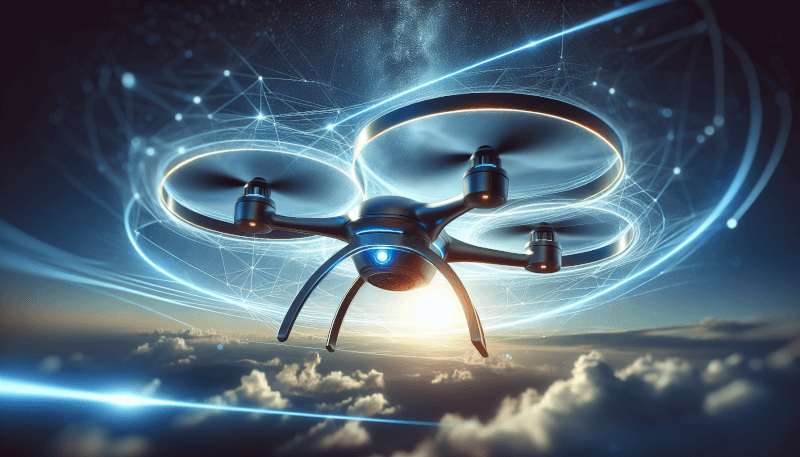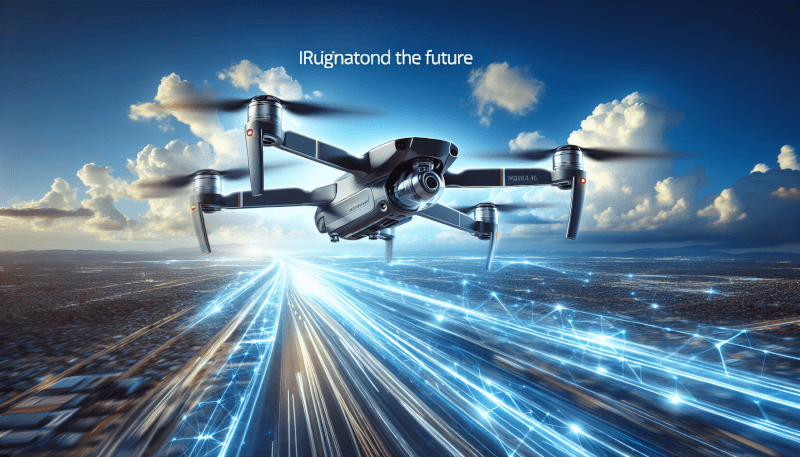Imagine a world where drones fly effortlessly through the sky, completing missions and tasks without any human assistance. This captivating article explores the exciting future of autonomous flight technology in drones. From delivering packages to gathering vital data, the possibilities for these unmanned aerial vehicles are endless. Join us as we delve into the advancements, benefits, and potential challenges that come with the integration of this remarkable technology in the world of drones. Get ready to envision a future where the sky is no longer a limit for innovation and progress.
Current State of Autonomous Flight Technology
Autonomous flight technology has made significant advancements in recent years, revolutionizing the capabilities of drones and opening up a whole new realm of possibilities. Drones, also known as unmanned aerial vehicles (UAVs), are now capable of operating without direct human control, thanks to the integration of advanced artificial intelligence (AI), computer vision systems, and improved sensor technology.
Benefits of Autonomous Flight Technology
Autonomous flight technology offers numerous benefits that have the potential to transform various industries. Firstly, it increases efficiency and productivity by reducing the need for human intervention. Drones can perform tasks faster and with higher precision, resulting in cost savings and improved overall performance. Autonomous drones also have the ability to access hard-to-reach areas, making them invaluable in situations where human intervention may be dangerous or impractical.
Furthermore, autonomous flight technology opens up opportunities for innovation and creativity. With the ability to perform complex aerial maneuvers and collect vast amounts of data, drones can provide valuable insights in various fields such as agriculture, surveillance, infrastructure maintenance, and search and rescue operations. These insights can lead to improved decision-making, increased safety, and enhanced operational efficiency.

Challenges and Limitations of Current Autonomous Systems
While the advancements in autonomous flight technology are exciting, there are also several challenges and limitations that need to be addressed. One major challenge is the development and integration of reliable AI systems that can effectively navigate and make informed decisions in complex and dynamic environments. Ensuring the safety and reliability of these systems is of utmost importance to prevent accidents and mitigate potential risks.
Another limitation is the regulatory framework surrounding autonomous drones. The current regulations often lag behind the rapid pace of technological advancements, making it challenging for businesses and individuals to fully leverage the potential of autonomous flight technology. There is a need for clearer guidelines and standards to ensure the safe and responsible use of drones.
Advancements in Drone Autonomy
The development of artificial intelligence (AI) for drones is a major driver of advancements in autonomous flight technology. AI enables drones to analyze and interpret data in real-time, making autonomous decisions based on their understanding of the environment. Machine learning algorithms allow drones to continuously improve their performance and adapt to changing conditions.
Integration of computer vision systems has also played a crucial role in enhancing drone autonomy. Computer vision allows drones to perceive and understand their surroundings, enabling them to navigate obstacles, avoid collisions, and accurately locate targets. This technology has applications in various fields, such as infrastructure inspection, surveillance, and search and rescue operations.
Improved sensor technology is another key factor in the advancement of autonomous flight. Sensors such as GPS, LiDAR, and cameras provide drones with valuable data about their position, orientation, and environment. This data is crucial for autonomous navigation, obstacle detection, and precise maneuvering. Ongoing advancements in sensor technology, including miniaturization and increased accuracy, are further enhancing the capabilities of autonomous drones.

Applications of Autonomous Drones
The applications of autonomous drones are vast and continue to expand as technology progresses. One of the most promising applications is in delivery services. Autonomous drones can efficiently transport goods and reduce delivery time, particularly in remote or difficult-to-access areas. Companies like Amazon and Google have already started testing autonomous drone delivery systems, and it won’t be long before this becomes a commonplace method of delivery.
Aerial surveillance and security are also areas where autonomous drones are making a significant impact. Drones equipped with advanced camera systems and AI algorithms can monitor large areas, detect suspicious activities, and provide real-time video footage to security personnel. This enhances situational awareness, improves response times, and reduces security risks.
Inspecting and maintaining infrastructure is another important application of autonomous drones. Drones can autonomously inspect bridges, buildings, power lines, and other critical infrastructure, identifying potential issues and minimizing the need for manual inspections. This not only saves time and resources but also increases safety by reducing the need for workers to carry out risky tasks at heights or in hazardous environments.
In search and rescue operations, autonomous drones play a crucial role in locating missing persons or survivors in disaster-hit areas. Equipped with thermal cameras, drones can quickly scan large areas and transmit live video feeds to rescue teams, providing valuable information for effective rescue operations. Autonomous drones can navigate through challenging terrains and offer a bird’s-eye view, aiding in identifying the most effective rescue strategies.
Agriculture is yet another field benefiting from autonomous drone technology. Drones equipped with multispectral cameras and AI algorithms can gather data on crop health, soil conditions, and irrigation needs, enabling farmers to make informed decisions about fertilization, pest control, and irrigation management. This not only improves crop yields but also reduces resource wastage, making agriculture more sustainable.
Regulations and Safety Concerns
While the potential benefits of autonomous drone technology are vast, it is essential to address the regulatory and safety concerns associated with its use. Establishing a legal framework that governs the operation of autonomous drones is crucial to ensure safe and responsible deployment. This framework should outline the rules and guidelines for drone operations, including airspace restrictions, privacy protection, and data usage.
Privacy and data protection are significant concerns when it comes to autonomous drones. As these drones become more advanced, they have the ability to capture and transmit vast amounts of data, including personal information. Regulations must be put in place to protect individual privacy rights and ensure that drone operators handle and store data securely.
Collisions and air traffic management present additional challenges. As the number of autonomous drones in the airspace increases, measures must be implemented to prevent mid-air collisions and ensure smooth traffic flow. This may involve the development of an integrated air traffic management system specifically designed for autonomous drones, along with mandatory safety features such as collision avoidance systems.

Economic Impact of Autonomous Drone Technology
The economic impact of autonomous drone technology is significant and far-reaching. Firstly, it has the potential to create job opportunities and spur industry growth. As the demand for autonomous drones and related technologies increases, new jobs will be created in areas such as drone manufacturing, software development, data analysis, and drone operations. This can lead to the growth of a thriving drone industry, contributing to economic development and innovation.
Moreover, autonomous drones offer the potential for decreased operational costs. By automating tasks that were previously done manually, such as inspection and surveillance, businesses can reduce labor costs and increase efficiency. Autonomous delivery drones, for example, have the potential to significantly reduce shipping costs for companies, enabling them to offer faster and more cost-effective delivery options.
Autonomous drone technology also enables the development of innovative business models. With the ability to perform tasks more efficiently and access hard-to-reach areas, drones can unlock new services and revenue streams. For example, companies can offer specialized inspection services using autonomous drones, allowing them to provide valuable data and insights to clients in various industries. These innovative business models have the potential to disrupt traditional industries and create new opportunities.
Environmental Benefits of Autonomous Drones
One of the most significant advantages of autonomous drone technology is its positive impact on the environment. By reducing fuel consumption and carbon emissions, autonomous drones promote environmental sustainability.
Autonomous drones are much more fuel-efficient compared to traditional manned aircraft. They consume significantly less fuel, enabling longer flight times and increased operational capabilities. This reduced fuel consumption not only saves costs but also reduces the demand for fossil fuels, contributing to the overall reduction of carbon emissions.
Furthermore, the use of autonomous drones in various industries can lead to lower carbon emissions. For example, in the agriculture sector, drones equipped with multispectral cameras can accurately identify areas of the fields that require treatment, minimizing the use of fertilizers and pesticides. This targeted approach reduces the environmental impact of agricultural practices, leading to better soil and water quality.
Autonomous drones also play a vital role in wildlife conservation efforts. With their ability to survey vast areas and gather data on animal populations, drones provide valuable insights into habitat conditions and the movement of endangered species. This information can guide conservation strategies and help protect wildlife and their ecosystems.

Ethical Considerations in Drone Autonomy
As autonomous drone technology continues to advance, ethical considerations become increasingly important. Accountability and liability are essential aspects to address. In situations where autonomous drones are involved in accidents, determining who is responsible becomes complex. Clear guidelines and regulations need to be in place to establish accountability and liability frameworks that can address potential damages and ensure appropriate compensation is provided.
Ethical use of drone technology is another vital consideration. Drones equipped with advanced capabilities such as facial recognition and AI algorithms raise concerns about privacy invasion. Strict regulations must be in place to govern the use of these technologies, ensuring that they are not misused or employed to violate individual privacy rights. Public awareness and education about ethical drone usage are also crucial to promote responsible practices among drone operators and users.
Future Challenges and Opportunities
While the current advancements in autonomous drone technology are impressive, there are still challenges that need to be overcome and opportunities to be explored. Testing and validation of autonomous systems are ongoing efforts to ensure their safety and reliability. Rigorous testing procedures and simulation techniques are necessary to identify potential limitations and refine the performance of autonomous drones.
Technological advancements also present opportunities for further improvements in autonomous flight technology. Ongoing research and development are focused on enhancing AI systems, developing more advanced computer vision algorithms, and improving sensor technology. These advancements will continue to push the boundaries of autonomous flight capabilities and open up new possibilities for drone applications.
Furthermore, public perception and acceptance of autonomous drones are crucial for their widespread adoption. Building trust and confidence among the general public, addressing concerns about safety, privacy, and potential job displacement, is essential to ensure the successful integration of autonomous drones into society. Education and public awareness campaigns can play a significant role in fostering acceptance and dispelling misconceptions about autonomous drone technology.

Collaboration and Partnerships
Collaboration and partnerships between governments and the industry are vital for the continued advancement of autonomous drone technology. Governments need to work closely with industry stakeholders to establish clear regulatory frameworks that encourage innovation while ensuring safety and responsible use. Sustained investment in research and development, as well as fostering collaboration between academia, industry, and government research institutions, is crucial for driving advancements in autonomous flight technology.
Partnerships for research and development are also essential for addressing the complex challenges associated with autonomous drone technology. Bringing together experts from diverse fields such as AI, robotics, aerospace engineering, and data science can foster innovation and accelerate technological advancements. Establishing collaborative platforms and funding initiatives can encourage cross-disciplinary research and facilitate knowledge sharing.
Conclusion
The future of autonomous drone technology is promising, with significant advancements already transforming various industries. From delivery services to surveillance and infrastructure inspection, autonomous drones are revolutionizing the way tasks are performed, increasing efficiency, and unlocking new opportunities. However, challenges related to regulation, safety, and public perception need to be addressed to fully realize the potential of autonomous flight technology. By fostering collaboration, driving technological advancements, and promoting ethical practices, we can create a future where autonomous drones enhance our lives and contribute to a sustainable and prosperous society.


